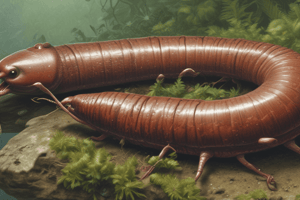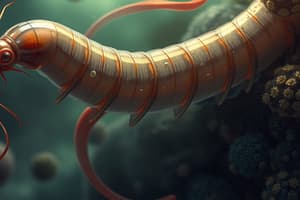Podcast
Questions and Answers
The leeches belong to the subclass:
The leeches belong to the subclass:
- Clitellata
- Polychaeta
- Annelida
- Hirudinea (correct)
The leeches belong to the class:
The leeches belong to the class:
- Polychaeta
- Clitellata (correct)
- Oligochaeta
- Hirudinea
There are approximately ____ species of leeches.
There are approximately ____ species of leeches.
500
Most leeches live in freshwater, others are marine or completely terrestrial.
Most leeches live in freshwater, others are marine or completely terrestrial.
Leeches prey on small invertebrates or feed on the body fluids of:
Leeches prey on small invertebrates or feed on the body fluids of:
Leeches lack parapodia and head appendages.
Leeches lack parapodia and head appendages.
Leeches are dorsoventrally flattened and taper _____.
Leeches are dorsoventrally flattened and taper _____.
How many segments does a leech have?
How many segments does a leech have?
The segments of a leech are secondarily divided into sections called:
The segments of a leech are secondarily divided into sections called:
Each leech segment has several:
Each leech segment has several:
The anterior and posterior segments of a leech are usually modified into:
The anterior and posterior segments of a leech are usually modified into:
Which group of annelids have the most complex musculature?
Which group of annelids have the most complex musculature?
Leeches have a layer of _____ muscles between their circular and longitudinal muscles.
Leeches have a layer of _____ muscles between their circular and longitudinal muscles.
Leeches are flat due to dorsoventral _____.
Leeches are flat due to dorsoventral _____.
The leech _______ has lost its septa, and is now filled with connective tissue resulting in a series of interconnecting sinuses.
The leech _______ has lost its septa, and is now filled with connective tissue resulting in a series of interconnecting sinuses.
Leeches are sometimes called parasites. However, the association between a leech and its host is brief, so maybe it is better to call leeches ____.
Leeches are sometimes called parasites. However, the association between a leech and its host is brief, so maybe it is better to call leeches ____.
Leeches are not species specific.
Leeches are not species specific.
Leeches are _____ specific.
Leeches are _____ specific.
The mouth of a leech is located in the center of the:
The mouth of a leech is located in the center of the:
In some leeches, the anterior digestive tract is modified into a protrusible ________, lined inside and outside by a cuticle, that they use to thrust into the tissues of the host.
In some leeches, the anterior digestive tract is modified into a protrusible ________, lined inside and outside by a cuticle, that they use to thrust into the tissues of the host.
In some leeches, the mouth is armed with three chitinous _____ it uses to slice through host tissues.
In some leeches, the mouth is armed with three chitinous _____ it uses to slice through host tissues.
Leeches secrete an anticoagulant called ______ from their salivary glands that prevents blood from clotting.
Leeches secrete an anticoagulant called ______ from their salivary glands that prevents blood from clotting.
Body fluids from the prey are pumped by a muscular _______ posterior to the leech's mouth.
Body fluids from the prey are pumped by a muscular _______ posterior to the leech's mouth.
Leeches have a large stomach with lateral cecae because they gorge themselves when feeding on body fluids increasing their body mass __________ times.
Leeches have a large stomach with lateral cecae because they gorge themselves when feeding on body fluids increasing their body mass __________ times.
After engorgement, a leech can tolerate periods of fasting that may last for months.
After engorgement, a leech can tolerate periods of fasting that may last for months.
Leeches exchange respiratory gases through their:
Leeches exchange respiratory gases through their:
Most leeches have a highly modified circulatory system where ______ sinuses replace blood vessels.
Most leeches have a highly modified circulatory system where ______ sinuses replace blood vessels.
In most leeches, coelomic fluid has taken over the function of:
In most leeches, coelomic fluid has taken over the function of:
Most leeches lack respiratory pigments.
Most leeches lack respiratory pigments.
The ventral nerve cords are unfused in leeches.
The ventral nerve cords are unfused in leeches.
Leeches lack a circumpharyngeal nerve ring.
Leeches lack a circumpharyngeal nerve ring.
Most leeches have photoreceptor cells in pigment cups along the dorsal surfaces of the ______ segments.
Most leeches have photoreceptor cells in pigment cups along the dorsal surfaces of the ______ segments.
Normally, leeches are negatively phototactic, but when searching for ______, the behavior of some leeches changes and they become positively phototactic.
Normally, leeches are negatively phototactic, but when searching for ______, the behavior of some leeches changes and they become positively phototactic.
Hirudo medicinalis, the ________, has a well-developed temperature sense, which helps it to detect the higher body temperature of its mammalian prey.
Hirudo medicinalis, the ________, has a well-developed temperature sense, which helps it to detect the higher body temperature of its mammalian prey.
Some leeches are attracted to ______ of prey tissues.
Some leeches are attracted to ______ of prey tissues.
All leeches have sensory cells with terminal bristles in a row along the middle annulus of each segment. These sensory cells, called _______, are of uncertain function.
All leeches have sensory cells with terminal bristles in a row along the middle annulus of each segment. These sensory cells, called _______, are of uncertain function.
Flashcards are hidden until you start studying
Study Notes
Leeches Overview
- Leeches are classified under the subclass Hirudinea and class Clitellata.
- Approximately 500 species of leeches are known to exist.
Habitat and Feeding
- Leeches predominantly inhabit freshwater environments, although some species are marine or terrestrial.
- They primarily prey on small invertebrates or feed on the body fluids of vertebrates.
Anatomy and Structure
- Leeches are dorsoventrally flattened and taper anteriorly.
- Each leech has 34 segments, which are not easily distinguishable externally due to secondary divisions called annuli.
- The anterior and posterior segments are modified into suckers for attachment.
- Leeches lack parapodia and head appendages.
Musculature and Locomotion
- Leeches possess the most complex musculature among annelids, including oblique muscles between circular and longitudinal muscles.
- Dorsoventral muscles contribute to their flattened structure.
Coelom and Feeding Mechanism
- The coelom in leeches is modified, losing segmentation and filled with connective tissue, thus forming interconnecting sinuses.
- Leeches can be considered predators rather than true parasites, with brief interactions with their hosts.
- A leech's mouth is located in the center of the anterior sucker and may have a protrusible proboscis for feeding on host tissues.
Digestive System
- Some leeches have three chitinous jaws in their mouth for slicing through host tissues.
- They secrete hirudin, an anticoagulant, which prevents blood from clotting during feeding.
- The muscular pharynx pumps body fluids from the prey into the leech's stomach, which can expand significantly, allowing for mass increases of 2-10 times.
Survival and Adaptation
- After feeding, leeches can survive prolonged fasting periods lasting months.
- Respiration occurs through the body wall, with most leeches lacking respiratory pigments.
Nervous System
- Leeches have unfused ventral nerve cords and possess a circumpharyngeal nerve ring.
- Photoreceptive cells are located in pigment cups on the dorsal surfaces of anterior segments.
Behavior
- Normally negatively phototactic, leeches exhibit positive phototaxis when searching for prey, enhancing their hunting success.
- The medicinal leech, Hirudo medicinalis, has a keen sense of temperature to detect warm-blooded prey.
- Some leeches are attracted to chemical extracts from prey tissues, aiding in detecting hosts.
Sensory Systems
- Sensory cells, called terminal bristles, are present along the middle annulus of each segment, though their exact function remains uncertain.
Studying That Suits You
Use AI to generate personalized quizzes and flashcards to suit your learning preferences.




